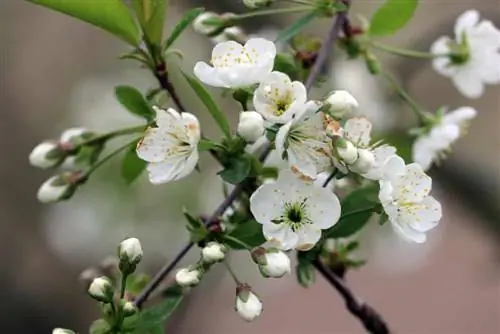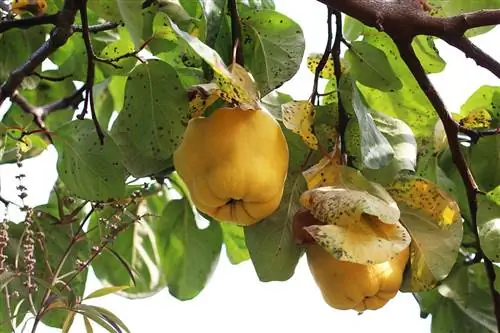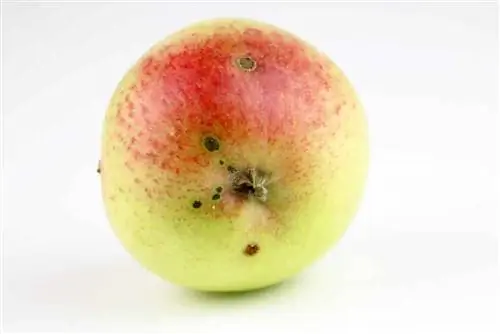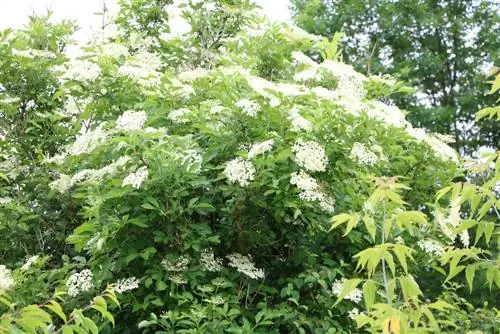- Author admin [email protected].
- Public 2023-12-17 03:39.
- Last modified 2025-01-24 12:45.
Most apple varieties are self-sterile, meaning they cannot pollinate their flowers with their own pollen. Therefore, you should always plant at least two apple trees in the garden, which must also bloom at the same time. However, it is not enough to simply plant two trees of the same variety next to each other: in fact, you need a suitable second variety as a pollen donor. If you live in a fruit-growing area or whose neighbors have suitable apple varieties in their gardens, you can make do with just one tree. Everyone else plants either a so-called “duo tree” or two matching variants.
On the diversity in the apple kingdom
Apple seeds are usually very easy to germinate. But anyone who tries this type of propagation will not only have to wait a long time for a tree to grow: they will also experience surprises, as the offspring are very different and hardly correspond to the mother plant. This is due to the fact that almost all apple varieties require a second variety for fertilization and therefore all seeds have a mixed genetic makeup. This means that practically every apple core produces a new variety. In fact, many tried and tested varieties were created this way. Suitable random seedlings were propagated vegetatively, i.e. via plant parts, so that they retained their properties unchanged. This happens almost exclusively via the finishing method.
Tip:
Instead of planting two apple trees in the garden, you can also use a so-called “duo tree”. Two matching varieties were grafted onto one trunk and can thus fertilize each other.
Why apples don't want to fruit and what helps against it
The fact that most apples cannot fertilize their flowers with their own pollen often leads to disappointment in practice - namely when there is no suitable second variety available for fertilization. Unfortunately, not all apple varieties that bloom at the same time are compatible with each other. The so-called triploid varieties such as “Boskoop” and “Jonagold”, for example, are generally considered poor pollen donors. It's best to get advice about suitable pollinator varieties from a good tree nursery.
Late frosts during the flowering period can also prevent fruit production, but you can clearly see this in the flowers. Weather influences, on the other hand, are less obvious when they are very unfavorable for the spring development of bees and bumblebees and these then largely fail as pollinators. A diverse garden planting that is as close to nature as possible with a rich range of flowers from spring to autumn also benefits the apple harvest, as the pollinating insects feel permanently at home in such an environment. It is also extremely important to avoid using pesticides that are harmful to bees - especially when fruit trees are in blossom.
Tip:
The increasingly popular columnar and dwarf apples are hardly available in the well-known apple varieties. Instead, they are special breeds suitable for small gardens with their own variety names, some of which are even considered self-fertile.
Popular apple varieties for the garden
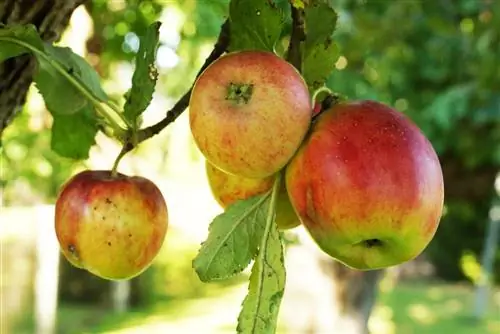
In the overwhelming abundance of apple varieties, some particularly popular apples such as “Golden Delicious” or “James Grieve” stand out. There are also a number of old local varieties that have proven to be particularly robust due to their adaptation to the regional climate and often offer an intense taste experience. The breedings from the fruit breeding institute in Pillnitz near Dresden should also be highlighted: the so-called “Pi” varieties such as “Pinova” are considered to be very robust against common apple diseases, while the “Re” varieties such as “Rewena” etc.are even resistant to scab, mildew and partly also to fire blight and are insensitive to winter and spring frosts.
List of popular apple varieties
When selecting apple varieties, the gardener also differentiates between summer and early autumn apples as well as autumn and winter apples. While the early varieties should be consumed immediately after harvest and can usually not be stored, the latter usually only reach their full ripeness for consumption some time after picking. The late varieties can often be stored for several months.
“Alkmene”
This is a tried and tested autumn variety that went on sale as early as 1961. The variety is less susceptible to scab and mildew and can be grown in almost all locations due to its robustness. However, a prerequisite is nutrient-rich soil. The very aromatic fruit tastes sweet and sour and is quite similar in aroma to the parent variety “Cox Orange”. The apples ripen between early and mid-September and are suitable for both fresh consumption and as dessert apples.
Suitable pollinator varieties are “Prima”, “Klarapfel”, “James Grieve”, “Goldparmäne”, “Klarapfel” and “Cox”
“Pineapple Renette”
This very aromatic variety with the white-yellow, juicy and wine-sour flesh has been cultivated since the beginning of the 19th century. However, it prefers warm locations and is not suitable for wet, cold and/or dry soils. The variety ripens between mid to late October and can be eaten fresh or stored for quite a long time. The “Pineapple Renette” is also very suitable for making puree, compote or juice.
Suitable pollinator varieties are “Alkmene”, “Cox”, “Geheimrat Oldenburg”, “Goldparmäne” and “Klarapfel”
“Berlepsch”
This is also a tried and tested, historical winter variety that was developed towards the end of the 19th century. Century emerged, among other things, from the “Ananasrenette”. In addition to the light variety, there is also a red-skinned mutant, “Roter Berlepsch”, which is probably even more popular. “Berlepsch” is only slightly susceptible to scab and mildew, but prefers a warm, protected location due to its susceptibility to wood and flower frost. The very juicy and aromatic fruits ripen in October and are suitable for fresh consumption, as table and storage apples and for making puree and compote.

“Beautiful from Boskoop”
There are a whole range of different yellow and red-skinned types of this well-known, historical variety. The “Red Boskoop” has proven particularly successful due to its robustness and the fine aroma of its fruits. The fruits ripen from mid-October, but should be harvested as late as possible because of the higher sugar production. Boskoop apples are grown less for fresh consumption and more for processing in the kitchen.
Suitable pollinator varieties are “Alkmene”, “Berlepsch”, “Cox”, “Gloster”, “Idared”, “James Grieve” and “Klarapfel”
“Cox Orange”
There are also numerous variants of the “Cox Orange”, which was bred in England around 1830, including the red-skinned “Red Cox Orange” and the “Holsteiner Gelber Cox”, which is listed as a separate variety. The variety is considered to be quite sensitive to frost and various diseases and needs deep, nutrient-rich and permeable soil and a warmer location. However, it is an apple suitable for both fresh consumption and storage with an excellent, very typical aroma.
Suitable pollinator varieties are “Alkmene”, “Berlepsch”, “Elstar”, “Goldparmäne”, “Pinova”, “James Grieve” and “Ontario”
“Elstar”
This is an autumn or winter variety with comparatively large fruits that ripen from the end of September and are very tasty. In addition to the yellow variant, there is also an equally excellent red-shelled mutant called “Red Elstar”. The variety is only slightly susceptible to scab and mildew.
Suitable pollinator varieties include “Gala”, “Golden Delicious”, “Gloster”, “James Grieve”, “Jonathan”, “Spartan” and “Summerred”
“Gala Delicious”
“Gala” or “Gala Delicious” comes from New Zealand and produces a very juicy, sweet and delicately aromatic apple that ripens from the end of September. The “Royal Gala” variant (also known as “Tenroy”) is colored more intensely red. Both varieties are ideal for fresh consumption as well as for making puree and compote.
Suitable pollinator varieties are “Cox Orange” and “Jonathan”
Tip:
“Gala” should not be planted together with “Golden Delicious” as both varieties are intersterile.
“Golden Delicious”
This apple, also known as the “Yellow Delicious”, is probably one of the most famous apple varieties of all. It is a winter variety whose medium to large fruits can be picked from around the end of October. However, harvesting should not be done too early as this results in a low-sugar, bland flavor. If possible, “Golden Delicious” should only be grown in warm locations (wine-growing climate is ideal).
Suitable pollinator varieties are “Cox”, “Discovery”, “Elstar”, “Gloster”, “Goldparmäne”, “James Grieve” and “Pilot”
“Idared”
This rather slow-growing apple variety has been on the market since 1942. The robust but mildew-prone tree produces juicy fruits with a mild, rather sour aroma from the end of October. “Idared” is ideal for planting a hedge.
Suitable pollinator varieties are “Bell Apple”, “Goldparmäne”, “James Grieve”, “Pilot” and “Reglindis”

“James Grieve”
The variety, which originally comes from Scotland, has been on the market since 1890. The medium to large fruits can be picked from the beginning of September and have a very typical, sour-sweet aroma. Both the yellow and the red versions are very suitable for fresh consumption, but also for preserving, making juice and as a topping for cakes and tarts.
Suitable pollinator varieties are “Alkmene”, “Berlepsch”, “Cox”, “Glockenapfel”, “Goldparmäne”, “Idared” and “Klarapfel”
“Jonagold”
“Jonagold” is the result of a cross between “Golden Delicious” and “Jonathan” and produces large, red-yellow and very tasty dessert apples that are primarily suitable for fresh consumption. An equally popular variant is the mutant “Jonagored” from Belgium.
Suitable pollinator varieties are “Cox”, “Discovery”, “Elstar”, “Gloster”, “Goldparmäne” and “James Grieve”
“Pilot”
This breeding comes from the renowned Institute for Fruit Research in Dresden-Pillnitz and has been on the market since 1988. It is a very robust variety that is only slightly susceptible to disease and can be widely cultivated in all apple locations. The very tasty fruit can be picked from early to mid-October and has excellent storage properties.
Suitable pollinator varieties are “Elstar”, “Pinova”, “Melrose”, “Idared”, “Gloster”, “Reglinis” and “Reanda”
“Pinova”
The late-ripening variety “Pinova”, a cross between “Clivia” and “Golden Delicious”, also comes from the Dresden-Pillnitz Institute for Fruit Research. The sweet and sour tasting fruits are ideal for fresh consumption as well as for storage or further processing.
Suitable pollinator varieties are “Golden Delicious”, “Gloster” and “Idared”. “Pinova” is also very suitable as a pollen donor for “Golden Delicious” and “Gloster”
“Reglindis”
This is a high-quality autumn variety whose medium to large fruits can be picked from around mid-September. The Pillnitz breeding is ideal for fresh consumption, but also for the production of must and nectar.
Suitable pollinator varieties are “Prima”, “Retina”, “Rewena”, “Remo”, “James Grieve”, “Idared” and “Pikant”. Conversely, “Reglindis” is also considered a good pollen donor for other “Re” varieties
“Rewena”
The “Rewena” variety, which ripens from the beginning of October, also comes from Pillnitz, delivers a high yield and is resistant to all kinds of typical apple diseases. It is very suitable for both fresh consumption and for making apple juice.
Suitable pollinator varieties are “Prima”, “Reglindis”, “Remo”, “James Grieve”, “Idared”, “Undine”, “Pilot” and “Golden Delicious”. On the other hand, “Rewena” is a good pollen donor, among other things. for other “Re” varieties
Conclusion
The list of suitable apple varieties for the garden is unmanageably long: over 20,000 different varieties are known worldwide and the number is constantly increasing. The apple owes this diversity to its self-sterility, because like many types of pome fruit, the apple always needs a second variety for fertilization. There are therefore no self-pollinating apple trees; only some special columnar or dwarf apple varieties are declared as such. However, there are a number of varieties that are particularly suitable for hobby gardeners, which are resistant or at least insensitive to all kinds of diseases and also provide high yields of very tasty fruits.

